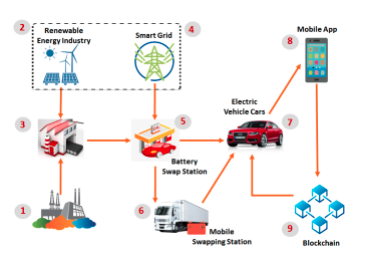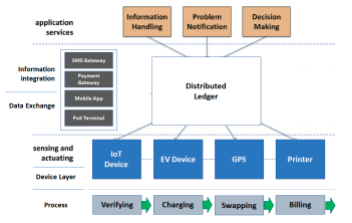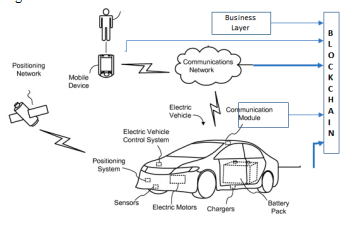HYBRID EV BATTERY CHARGING STATION

World has been changing rapidly, either we run along with it and adapt or stay behind and suffer. Climate change and fuel inflation has been forcing the world to look for alternate solution to address the growing needs of transportation and automobile. Electric Vehicles are already in the market but finding it difficult to capture the market due to challenges in battery charging. Powered by grid and supplied by manufacturing unit, battery charging stations has been proposed to address these challenges, mobile battery swapping has been another solution that takes care of covering vast areas. But this comes with its pain points such as standardization of batteries, commercially viable business model and reliability of batteries. This whitepaper provides solution to software technological challenges and pain points by building hybrid charging stations powered by IoT devices on a Blockchain platform …
To know more please submit the form below to download white paper for free
DOWNLOAD
Abstract:
World has been changing rapidly, either we run along with it and adapt or stay behind and suffer. Climate change and fuel inflation has been forcing the world to look for alternate solution to address the growing needs of transportation and automobile. Electric Vehicles are already in the market but finding it difficult to capture the market due to challenges in battery charging. Powered by grid and supplied by manufacturing unit, battery charging stations has been proposed to address these challenges, mobile battery swapping has been another solution that takes care of covering vast areas. But this comes with its pain points such as standardization of batteries, commercially viable business model and reliability of batteries. This whitepaper provides solution to software technological challenges and pain points by building hybrid charging stations powered by IoT devices on a Blockchain platform.
I. Introduction
State of the art integrated Hybrid battery charging and swapping system on a blockchain platform. Battery charging stations receives new battery supplies from the manufacturers assuming that the regulators are in place to ensure the standardisation of batteries across all the EV cars or the proposed model backed up by enough inventories maintained by Charging stations regardless of the battery specifications and car models.
A. Preamble
In Today’s world, Transportation is responsible for almost one by third of carbon emissions polluting the planet and causing climate change. And it leads to increasing shortage of non-renewable resources production and supply, excesssive fuel consumption due to fast growth of automobile industry, and market fluctuations of fuel supply and cost causing inflation. Thus, it forces the industry to look for alternate solution to address some of these global challenges.
Electric Vehicle could be one of the ideal solutions that has been discussed in the academia and industry forums quite often, but this solution has its own challenges. Electric Vehicles are already in the market but not yet established as much as vehicles run by fuels and gas.
EV cars expected to grow from 3 million to 125 million by 2030. Currently, delay in battery charging, connectivity, lack of battery charging stations, battery reliability and cost involved for charging batteries has been the pain points faced by EV industry. Capacity building using cutting edge technology is essential for EV industry to charge batteries.
II. HYBRID CHARGING SYSTEM USING BLOCKCHAIN AND INTERNET OF THINGS

Fig. 1. Represents the business process proposed for Hybrid Battery Charging Stations where EV driver and Battery Supplier as the main stakeholders. Find below the various states of the business model explained in Sec A.
A. Business Model
1. Battery manufacturer supplies new batteries to Charging units
2. Renewable Energy Industry supplies renewable energy for Charging units to recharge batteries
3. Charging units distributes fully charged batteries to Swapping stations and receives empty batteries from them
4. Smart Grid supplies electricity to Swapping stations to recharge batteries as an alternate solution
5. Battery Station verifies the EV model, EV battery specifications, swaps the batteries and bills for it.
6. Mobile Swapping Stations swaps the batteries using IoT devices, locates EVs based on GPS and delivers on special request from EVs
7. Electric Cars using IoT devices monitors and track the battery performance, life and car model and also reliability of swapped batteries
8. Mobile App for EV car owners to locate battery stations or send special request for mobile swapping, use Pay-by-Touch for billing
9. Data distributed across the blockchain
B. Process Overview

• Battery swapping station has two methods to restore its battery storage: from a battery charging unit with a battery logistics and from its own battery charging system
• Battery charging system by the stations is only used to charge the batteries that are swapped out and it is not open to EV users for balancing peak load in the smart grid
• Battery swapping stations supplies batteries through its service for the EV users directly and to restore the charged batteries to deliver indirectly a Mobile swapping service for the EV users
• EV users receive the battery swapping details which is distributed in the blockchain, and send their real-time battery swapping request via the mobile APP
• Smart Contracts verify and validate the reliability of the batteries. It takes the battery data from the EV cars using IoT and the verify with the swapped battery and distributes in the blockchain.
III. Solution
A. Technical Architecture & System Integration
The Proposed solution provides a modular architecture using Hyperledger Fabric that has been seamlessly integrated with IoT devices and analyse data using Big Data. Hyperledger Fabric: Offers a modular architecture to pluggin, plug-out solution for the system. Chaincodes has been created and integrated as a API using NodeJS into the system. Subnet Channels will be used to create sub networks adding additional layers for different set of organisations and roles. Smart Asset will be used for user authentication in the MSP protocol applying Zero Knowledge Proof protocol for data integrity and battery tracking as GeoSPARK. Services layer, application layer, data procesing layer, device manager layer and integration management layer will be used to manage the required functionalities of the entire system.

UI is built on a hybrid technology to bring out the omni-channel experience. APIs are built using NodeJS and CouchDB is being used for storing transactions on the Blockchain Platform and Fabric as a blockchain platform with its Hyperledger framework.
B. Electric Vehicle Battery Efficiency
Electric Vehicle Battery Efficiency System is derived from detailed physical and chemical characteristics. The method also includes charge and discharge effects modeling the real-life system behaviors of Lithium batteries, these includes the following
• Electronic conductors in the collectors and electrode materials,
• Lithium has to be solid-state diffused inside the highly porous electrodes,
• Solid Electrolyte Interphase (SEI) for transfer and integration of lithium ions
• Lithium needs to be diffused in electrolyte,
• Ohmic heating and kinetic energy generation,
• Neutral charge to balance the energy
Our proposed solution covers aspects ranging from Lithium technology to Battery Management System (BMS) requirements and architectures and techniques for battery
status estimation and charge equalization. This will be implemented to the design of a cutting-edge BMS to be integrated in an electric vehicle. The implemented BMS includes the first almost fully-integrated active charge equalizer.
C. Battery Power Management
showcases how battery power can be managed through efficient charging or swapping using IoT devices. The system captures the efficiencies and specifications of the battery through various controller chips and the data has been distributed in the network which are readily available for auditing. Blockchain certifies the efficiency and reliability of the batteries for swapping.
Interaction of Battery Management Systems with Electric Vehicle owners, station owner and power grid. Network congestion and increasing peak load are two important factors faced by Power Grid in the process of charging batteries and sending power energy to the stations. This can be overcome by implementing the above described method. At each hour, every individual battery transits among these four states
D. Battery Location Tracking
The Solution is to use Proof-of-Origin protocol executed by Smart Contracts to track the battery location. The Protocol will be implemented across the network to remove the malfunctioning and vulnerabilities occurs on a centralized network. Whenever the GPS data has been received from the devices by the application, Smart Contract will execute this protocol along with a Digital Signature certification to prove the origin of the data without relying on a third party to come to a consensus thus eliminating any other liabilities involved.
Whenever the GPS data has been received from the devices by the application, Smart Contract will execute this protocol along with a Digital Signature certification to prove the origin of the data without relying on a third party to come to a consensus thus eliminating any other liabilities involved. Proof-of-Origin protocol when applied to secure the location data will use Zero Knowledge Proof (ZKP) in the Peer-to-Peer network as a secured means of protecting the data, the certification will be provided by the endorsing peers by validating the origin of the data without compromising the data confidentiality by allowing to know limited information for location validation.
The Protocol comprises of a GeoSPARK which is basically a spatially enabled big data to analyze and compute the location data accurately since GPS data comes from different types of devices.
E. User id & Authentication management
User can log into an account with a service by registering an account which is actually a few step processes.
Complete set up process of the account, the member informs the trusted device his login, and the trusted device proves knowledge of the login by a ZKP Protocol.
User selects a username and sends it to the Membership Services Protocol (MSP) via the trusted device. MSP uses Zero Knowledge Proof (ZKP) to verify the user and authenticated by the endorsing peers, which then commits the membership approval to the blockchain.
MSP generates a digital signature along with the keys for user authentication and shares it to the user, the whole functionality will be executed by the Smart Asset.
1V. BENEFITS
F. Highlights of Blockchain implementation
• Reliability
Any potential breach in the swapping process may lead to a serious disaster of this whole model since customers do not know the technical nuances of the batteries, blockchain plays a major role in ensuring the verification and validation of battery efficiencies and specifications would ensure the reliability of Hybrid battery stations
• Transparency
Every stakeholder can view the transactions recorded on a blockchain from the time it was created until the swapping of the batteries. Thus protects from forge or fraudulent data while battery request and invoices.
• Security
Literally every transaction on blockchains processed through are encrypted, making it not possible for fraudulent data.
• Smart Contracts
Business rules and processes can be carried out and executed automatically by Smart Contracts eliminating intermediaries and manual work
• Traceability
Traceability of car models, car and battery station location, swapping request, battery specifications and efficiencies etc. by retrieving data automatically using IoT devices and GPS devices and also by recording all transactions during the processes. Records are immutable and provides a tamper-proof evidence that guarantees the integrity of information.
G. Overall benefits of the proposed solution
Following points lists out the benefits of using a blockchain with the IoT and following the methodologies described in the above section for power grid, battery efficiency, battery charging and swapping for Hybrid battery charging stations
• EV users only pay money for the proposed mobile battery charging service according to the amount of energy that is necessary and the fixed price that is set by operators, thus EV users saves money
• The time delay and waiting time to charge the battery has been toxic for EV users, Hybrid Battery Swapping Service will help reduce the swapping time
• Accurate data, availability, battery model and efficiency calculation of the EV cars will be updated regularly by the IoT sensors to the system, which helps them to locate the Battery Swapping System, plan their drive and make sure battery is efficient
• Manufacturing units and Charging stations will be able to maintain inventory based on analysis provided by the system through the blockchain, thus they will be able to handle the supply chain.
• Service Request Priority can be set by the system based on the data from the distributed network, which will provide accurate information, time, battery requirements, cost etc. to the battery stations and the EV users
References
[1] Two Factor Zero Knowledge Proof Authentication System – whitepaper writtern by Quan Nguyen, Mikhail Rudoy and Arjun Srinivasan as 6.857 Spring 2014 Project
[2] Tracing and Tracking with the Blockchain – whitepaper written by Pietro Palamara for Politecnico Milano 1863 in 2017-2018
[3] Battery and Battery Management Systems – Conference: 2012 Design, Automation & Test in Europe Conference & Exhibition (DATE), At Dresden, Germany
[4] Intelligent Battery Management and charging for Electric Vehicles – document submitted by Sang Chon, C2000TM MCU Automative and Jon Beall, Monitoring and Protecting Binary Management Systems – Texas Instruments
[5] Electric Vehicle Battery Swapping Station – Whitepaper written by Mohsen Mahoor, Zohreh Hosseini, Amin Khodaei from University of Denver in Oct 2017